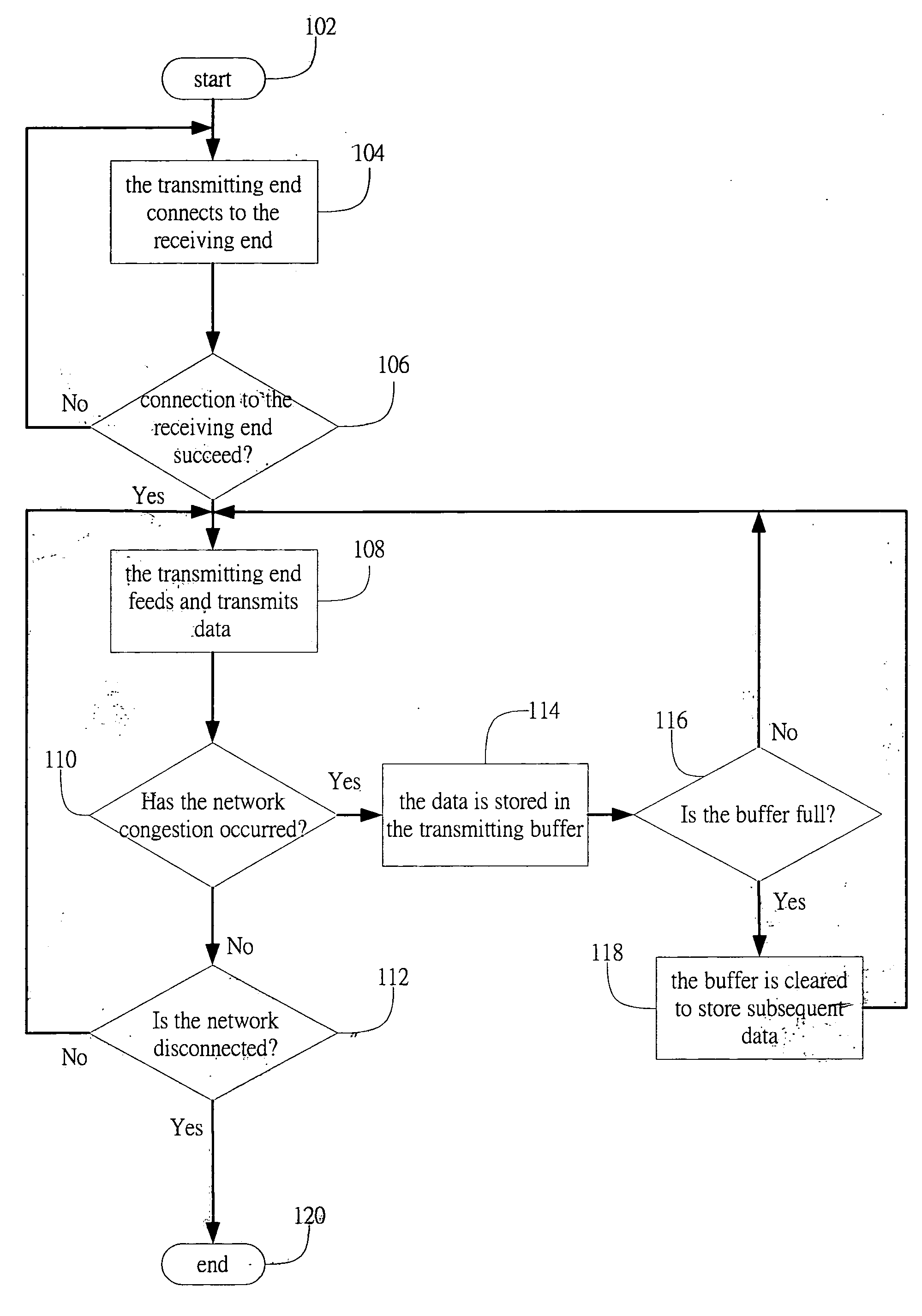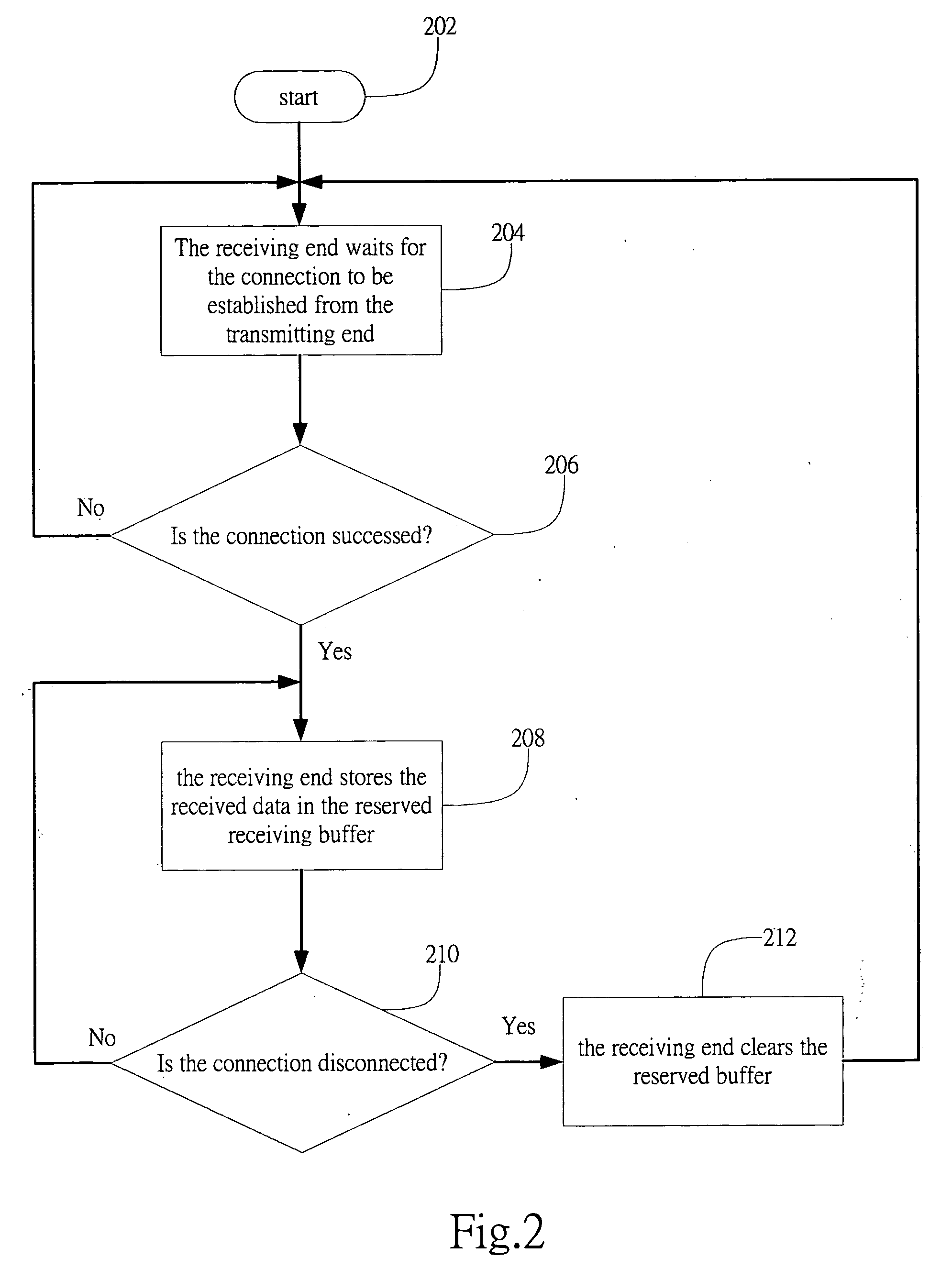Real-time and reliable method for transporting data
a real-time and reliable technology, applied in the field of data transportation, can solve the problems of reducing the speed of data transportation, affecting the audio and video quality at the receiving end, and unable to effectively compensate for data loss occurring during the transportation, so as to reduce the number of small packets, improve data transportation speed, and waste bandwidth
- Summary
- Abstract
- Description
- Claims
- Application Information
AI Technical Summary
Benefits of technology
Problems solved by technology
Method used
Image
Examples
first embodiment
[0024]FIG. 1 shows a flowchart of a transmitting data management method in accordance with the present invention. The method starts with step 102. In step 104, the transmitting end connects to the receiving end. The transmitting end determines whether the connection to the receiving end succeeds by a response from the receiving end, as in step 106. If the connection is unsuccessful, the transmitting end will repeat step 104 until the connection is established. Once the connection is successful, the transmitting end feeds and transmits data, as shown in step 108. During the transmission, the transmitting end continues to monitor the network communication to determine whether congestion has occurred, as in step 110. If there is congestion, the data is stored in the transmitting buffer (step 114) to wait for later transmitting. In the mean time, the transmitting end continues to monitor the buffer and determines whether the buffer is full (step 116). If the buffer is full, the buffer i...
second embodiment
[0025]FIG. 2 shows a flowchart of a receiving data management method in accordance with the present invention. The method starts with step 202. The receiving end waits for the connection to be established from the transmitting end (step 204), and continues to monitor and determines whether the connection is successful (step 206). The receiving end waits until the connection is successful. Once the connection is established, the receiving end stores the received data in the reserved receiving buffer (step 208). During the receiving period, the receiving end continues to monitor the network communication, as in step 210. If the connection continues, the subsequently received data is stored in the reserved buffer; otherwise, the receiving end clears the reserved buffer (step 212) and waits for re-connection.
third embodiment
[0026]FIG. 3 shows a flowchart of a playback data management method in accordance with the present invention. The method starts with step 302. In step 304, the receiving end stores the received data into the reserved buffer, and continues to monitor whether the reserved buffer is full. Step 305 is to determine whether the playback starts. If not, determines whether the reserved buffer is full (step 306). If the reserved buffer is not full, the receiving end continues to store the received data into the reserved buffer. If the reserved buffer is full or the playback has already started, the data is retrieved from the reserved buffer (step 308). Step 310 is to determine whether the data is successfully retrieved from the reserved buffer. If so, the playback device starts to play the data (step 312); otherwise, the receiving end returns to step 304 to store the received data into the reserved buffer.
[0027] In the above data management during the transmitting and receiving, a sliding wi...
PUM
 Login to View More
Login to View More Abstract
Description
Claims
Application Information
 Login to View More
Login to View More - R&D
- Intellectual Property
- Life Sciences
- Materials
- Tech Scout
- Unparalleled Data Quality
- Higher Quality Content
- 60% Fewer Hallucinations
Browse by: Latest US Patents, China's latest patents, Technical Efficacy Thesaurus, Application Domain, Technology Topic, Popular Technical Reports.
© 2025 PatSnap. All rights reserved.Legal|Privacy policy|Modern Slavery Act Transparency Statement|Sitemap|About US| Contact US: help@patsnap.com



